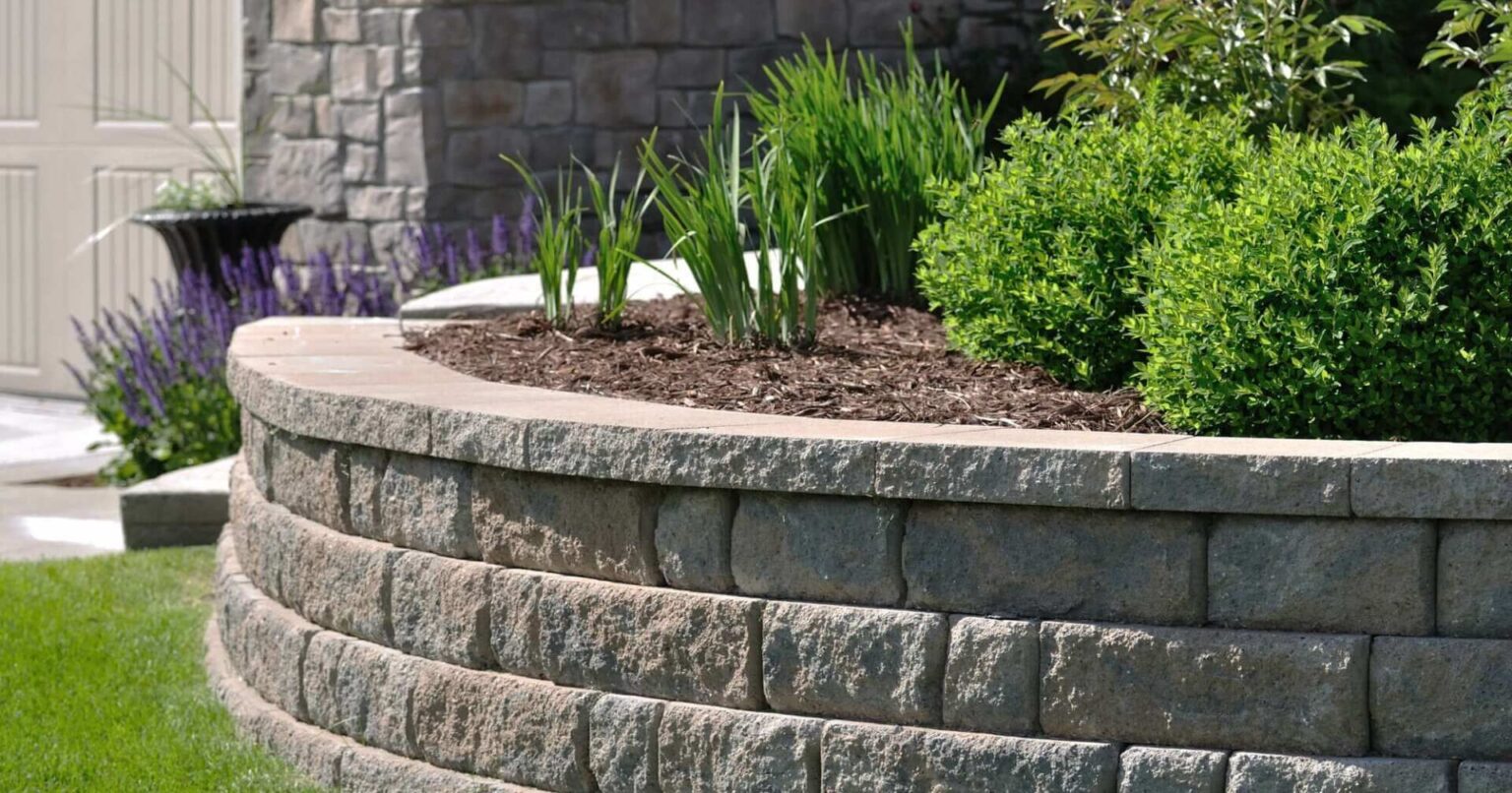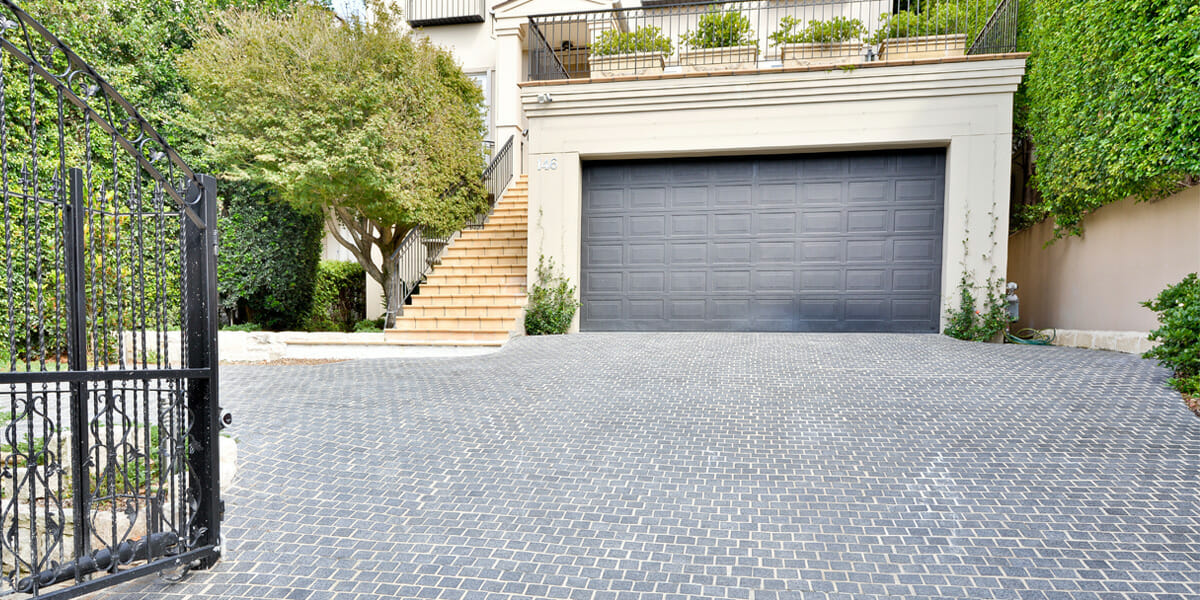
Retaining walls are more than just barriers against soil movement. They define space, add depth to garden design, and bring lasting visual impact to outdoor areas.
Whether it’s the bold strength of granite or the warm tone of sandstone, natural stone offers both function and form in one. It reinforces structure while adding timeless appeal that improves with age.
In this guide, you’ll learn which stones work best for retaining walls, the ideal finishes, key selection factors, and expert design tips to build with confidence.
Top Natural Stones for Retaining Walls
Choosing the right stone can transform your retaining wall from a simple support structure into a striking landscape feature. Here are the top natural stones that combine beauty with performance.
1. Granite
Granite offers unmatched durability and is ideal for structural retaining walls. Flamed or split face finishes add grip and rugged texture, as seen in varieties like Buffalo or Hotham used in modern landscapes.
2. Limestone
Limestone provides a refined, soft-toned look for garden walls. Finishes such as tumbled or natural split suit styles from Barwon to Beloka without compromising on resilience in outdoor settings.
3. Sandstone
Sandstone weathers gracefully, making it a favourite for rustic, dry-stack designs. Tumbled or split face finishes work well with varieties like Charlotte, Australiana, or Stirling in heritage or native-style landscapes.
4. Quartz
Quartz brings rich colour variation and natural strength, perfect for tiered or feature walls. Options like Shoreham, Kakadu, or Wyndham often feature brushed or split face textures for added depth.
5. Travertine
Travertine’s lightweight and textured surface suit smaller walls in dry climates. Filled or tumbled finishes complement warm-toned styles like Sorrento, Silver, or Classic for a clean, timeless look.
Why Choose Natural Stone for Retaining Walls?
Stone retaining walls do more than hold back soil. They define space, add natural character, and bring lasting function to the landscape. Here’s why stone belongs outdoors.
1. Delivers Lasting Strength and Structure
Natural stone offers superior resistance to cracking, movement, and weather damage. Its dense composition makes it ideal for retaining pressure over time, ensuring walls remain secure and reliable in all conditions.
2. Requires Minimal Upkeep
Stone retains its natural look with minimal maintenance. Occasional cleaning and resealing are typically all that’s needed, especially for finishes like tumbled or split face that hide marks and age gracefully.
3. Enhances Outdoor Aesthetics
Each stone type has unique tones and textures that blend beautifully with gardens and hardscapes. This organic variety gives outdoor spaces a refined, grounded appearance that feels timeless and visually rich.
4. Adds Long-Term Property Value
Well-crafted stonework signals quality and permanence. It boosts kerb appeal and often increases resale value, making it a smart investment for homeowners looking to enhance their outdoor living areas.
5. Offers a Sustainable Landscape Option
Natural stone is durable, recyclable, and free from synthetic treatments. It weathers naturally and integrates with the environment, making it an ideal choice for low-impact, sustainable landscape designs.
Key Factors to Consider When Choosing Stone for Retaining Walls
Choosing the right stone involves more than appearance. It’s about ensuring your wall stays strong and looks great for years. Use this guide to make confident, well-informed decisions.
1. Choose Stones with Suitable Strength
Select a stone type that can withstand the pressure behind your wall. Dense options like granite or quartz work best for tall or load-bearing walls in demanding environments.
2. Plan for Drainage and Moisture
Install appropriate drainage behind the wall and select stones that won’t trap excess water. Moisture-resistant materials and breathable finishes reduce the risk of damage or long-term erosion.
3. Align Wall Height with Stone Type
Use heavier, stronger stones for high walls or structural applications. For lower or decorative walls, you can opt for lighter varieties that allow more freedom in texture and finish.
4. Adapt to Your Local Climate
Select stone that suits your location’s conditions, whether hot and dry or cold and wet. Weather-resistant finishes and materials help prevent cracking, staining, and thermal stress over time.
5. Match the Design Style of Your Space
Coordinate the stone’s tone, texture, and pattern with other landscape features. Blending with pavers, architecture, or natural elements ensures a cohesive and intentional outdoor design.
6. Balance Cost with Long-Term Value
Set a realistic budget and explore local stone varieties to reduce freight and lead times. Prioritise quality and performance to avoid future repair costs or premature replacement.
Creative Design Ideas for Stone Retaining Walls
Stone retaining walls don’t have to be purely functional. With the right approach, they can become standout features in your landscape. Here are creative ways to elevate their impact.
1. Add Curves for a Natural Flow
Curved retaining walls soften the look of hard landscaping and help guide the eye through the space. They’re ideal for garden beds, pathways, or creating visual movement in wide open areas.
2. Incorporate Seating Ledges
A flat stone cap can double as a garden bench, offering practical use and added comfort. This works well in tiered designs or near patios where relaxation meets structure.
3. Highlight with Garden Lighting
Low-voltage lights installed along or behind the wall add depth and ambience. Lighting not only enhances safety at night but also brings out the stone’s natural texture after sunset.
4. Combine Multiple Stone Colours
Mixing tones within the same wall creates layered visual interest. Choose complementary colours from the same stone family to maintain consistency while adding subtle contrast and depth to the design.
5. Blend with Steps or Water Features
Integrate the wall into surrounding elements like garden stairs or fountains. This creates a seamless, cohesive look that connects levels and makes the landscape feel thoughtfully designed and complete.
Installation Methods for Stone Retaining Walls
How you install a retaining wall affects its strength, lifespan, and appearance. The right method depends on your wall’s height, location, and purpose. Here are the main approaches professionals use.
- Dry Stack: Stones are stacked without mortar, relying on weight and gravity for stability. This breathable method suits rustic or informal walls and allows water to pass through, reducing pressure and potential damage.
- Mortared Construction: Stones are bonded using mortar for added strength and long-term stability. Ideal for tall or load-bearing walls, this method resists movement and works well in areas with heavy rainfall or traffic.
- Stepped or Tiered Systems: Walls are built in layers with set-backs between levels, distributing pressure and following the slope of the land. This method improves drainage and creates space for planting or landscape lighting.
- Segmental Systems: Pre-cut or modular stone units interlock without mortar, offering precision and speed during installation. These systems are popular for uniform designs and DIY-friendly builds where consistent alignment is important.
Care and Maintenance Tips
Even the strongest retaining walls benefit from regular upkeep. A few simple habits can prevent bigger issues down the track. Here’s how to keep your stone wall performing and looking great.
- Clean the surface regularly: Use a soft broom or low-pressure hose to remove dirt, moss, and organic matter. Keeping the surface clean helps preserve the stone’s natural colour and finish over time.
- Check and clear drainage outlets: Inspect behind the wall for blocked weep holes or pooling water. Good drainage prevents water pressure buildup, which can weaken the structure or lead to unwanted stains and erosion.
- Reseal porous stones when needed: Some stones benefit from resealing every few years to maintain water resistance. Use breathable, penetrating sealers suited to your specific stone type to avoid trapping moisture inside.
- Monitor for mortar wear or shifting: Look for cracks in mortar joints or stones that have moved. Early repair prevents further damage and helps keep the wall stable, especially in areas exposed to heavy rainfall.
- Watch for signs of wall movement: Bulging, leaning, or loose stones can signal underlying issues. Act quickly to avoid larger structural repairs, particularly in taller or heavily loaded retaining walls.
Conclusion
Granite, limestone, sandstone, quartz, and travertine each bring unique strength and beauty to retaining walls. Choosing the right stone ensures lasting performance and visual impact.
For expert guidance and premium natural stone options, contact Splendour in Stone today. Our team can help you create a retaining wall that stands the test of time and elevates your entire landscape.
More To Explore

Grey Granite Cobblestones for Driveways: Strength and Style
Grey granite cobblestones combine strength, safety, and timeless appeal, making them a popular choice for Melbourne driveways and outdoor spaces. Their natural flamed texture offers

Granite Wall Cladding Melbourne: Modern and Classic Appeal
Granite wall cladding brings both modern sophistication and classic charm to Melbourne architecture. Known for its durability and natural beauty, granite transforms façades, feature walls,


